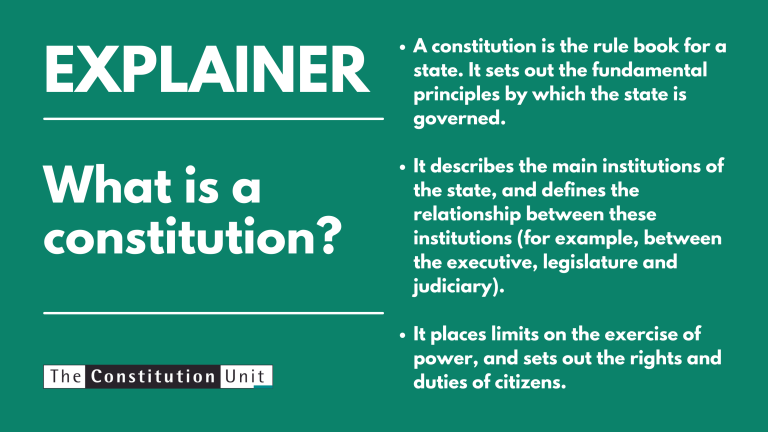
A constitution is the rule book for a state. It sets out the fundamental principles by which the state is governed. It describes the main institutions of the state, and defines the relationship between these institutions (for example, between the executive, legislature and judiciary). It places limits on the exercise of power, and sets out the rights and duties of citizens.
Most countries have the rule book codified in a single document, known as a codified (or written) constitution. Codified constitutions are typically produced following a revolution (like the American constitution of 1787 or the French constitution of 1791); or total defeat in war (like the post-war constitutions of Germany and Japan); or a complete collapse of legitimacy of the previous system of government (like post-apartheid South Africa, or post-Soviet Russia); or the attainment of independence (like all the countries of the former British empire). None of these things have happened to the UK, which is why it has never had cause to codify its constitution. (Our one revolution, in the 17th century, did briefly produce a written constitution: Cromwell’s Instrument of Government).
Codified constitutions contain fundamental, superior law, and are harder to amend than ordinary law. Constitutional change typically involves approval by a super-majority in the legislature, or a referendum, or sometimes both. For example, an amendment of the Japanese constitution requires approval by a super majority of two-thirds of both houses of the Diet, and then by simple majority in a popular referendum. Amendment of the US constitution usually requires a two thirds vote in both Houses of Congress, followed by ratification by three quarters (38 out of 50) of all the state legislatures.
Constitutional change can also be achieved by interpretation or re-interpretation of the constitutional text by the courts. Because of the high threshold required to amend the constitution, in some countries (such as the US) judicial decisions can be as important in revising the constitution as the process of formal amendment.
Both codified and uncodified constitutions rely heavily on constitutional conventions, which are norms guiding the key constitutional actors. The UK constitution relies on conventions to constrain the seemingly unfettered prerogative powers of the monarch. For example, by convention the King appoints as Prime Minister that person who is most likely to be able to command the confidence of the House of Commons. But the US constitution similarly relies on conventions. When electing the President, members of the Electoral College will generally reflect the popular vote in their state rather than their own preferences. This is not prescribed by the constitution: these members are merely following a long-held convention.
 Close
Close



